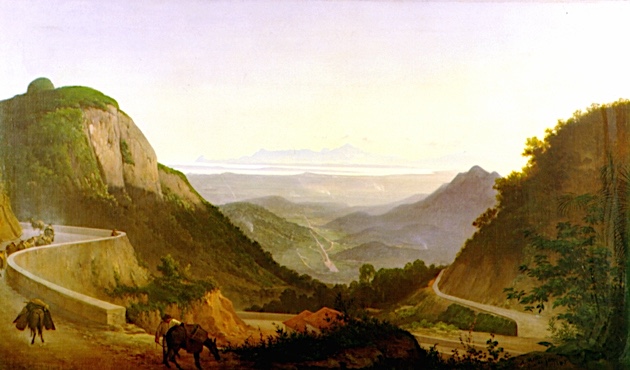Pico de Maria Comprida (1,926 m)
Brésil
In Paisagem do Rio de Janeiro, huile sur toile, 130 x 79cm
La montagne
Le Pico da Maria Comprida (1,926m) est connu parmi les grimpeurs brésiliens pour abriter la voie d'escalade Maria Nebulosa , qui fut également la première voie du pays avec plus de 1000 mètres de longueur. Avec la nouvelle zone de protection, les habitants de la région et les alpinistes prévoient d'explorer ces attractions de manière durable et de promouvoir ainsi l'écotourisme et le tourisme rural dans la région.
Le peintre
Agostinho José da Mota était peintre, dessinateur et professeur brésilien. Ainsi, en 1837, il s'inscrit à l'Académie Impériale des Beaux-Arts. Il fut un brillant élève et, pour ses mérites et ses compétences démontrés, il reçut le prix d'un voyage en Europe en 1850. De retour au Brésil, en 1856, il est l'un des fondateurs de la Société de propagation des beaux-arts de Rio de Janeiro. Deux ans plus tard, il peint les portraits du couple impérial - Dom Pedro II (1825 - 1891) et Dona Teresa Cristina (1822 - 1889). La majeure partie de la production artistique d'Agostinho de Motta est constituée de paysages et de natures mortes. Sa représentation du paysage brésilien est parmi les meilleures qui impriment les valeurs et les normes de l'Académie Impériale des Beaux-Arts (AIBA), dans laquelle il a étudié et a ensuite été professeur, tant dans la formation de l'idée d'image nationale que comme dans la formation de l’image de l’empire. Agostinho Mota l'a fait pour ses œuvres artistiques, comme le portrait du couple impérial et les archives de la scène de l'époque.Les paysages d'Agostinho Motta sont les œuvres les plus célèbres de l'artiste. Ils se distinguent par la précision topographique, par le registre exact des dimensions des scénarios et par la compétence avec laquelle ils capturent les transpositions entre les différentes couleurs qui constituent ses extérieurs travaillés. Les scénarios choisis par l'artiste démontrent la dimension marquée de l'identité nationale qu'Agostinho Mota entendait représenter dans ses peintures, comme le Paysage de Rio de Janeiro, ci dessus influencé par les canons de l'AIBA.
________________________________________
2011-2024 - Gravir les montagnes en peinture
Un blog de Francis Rousseau


